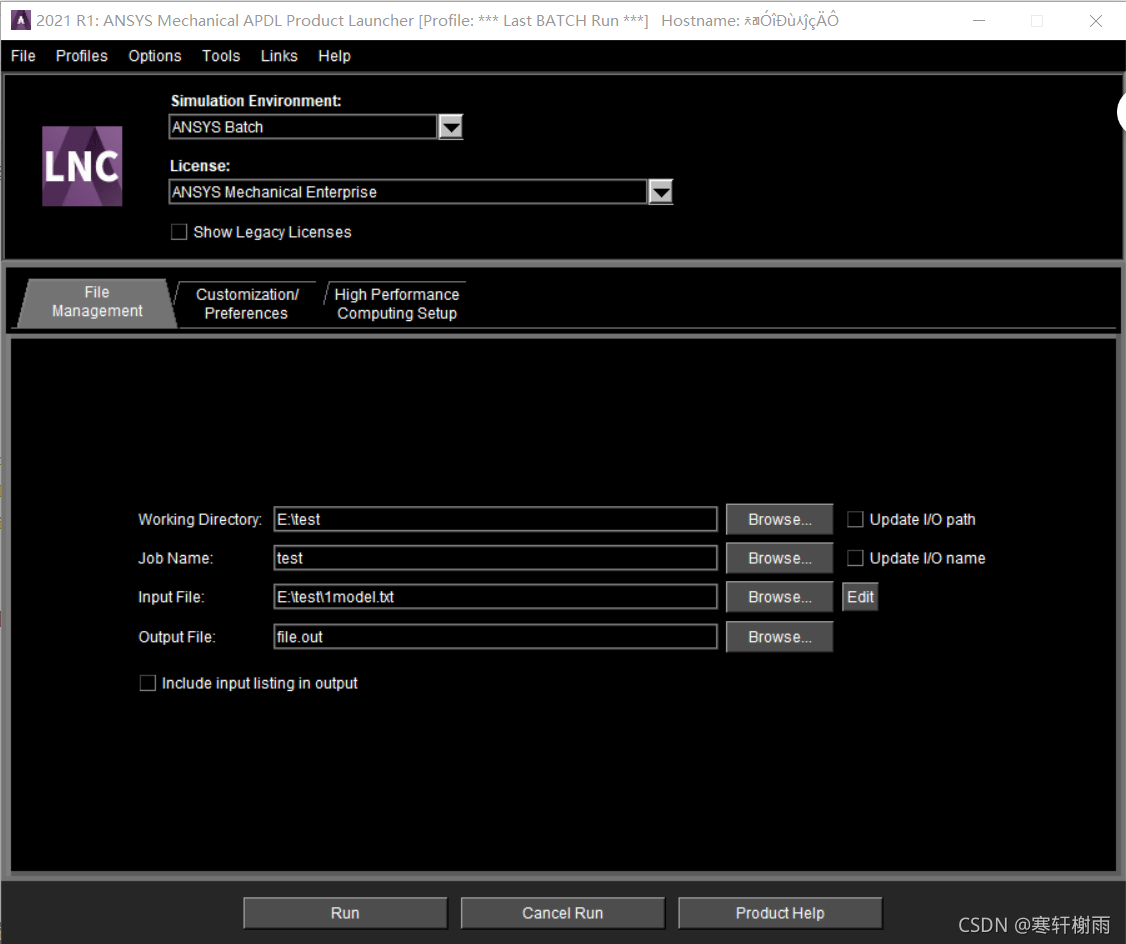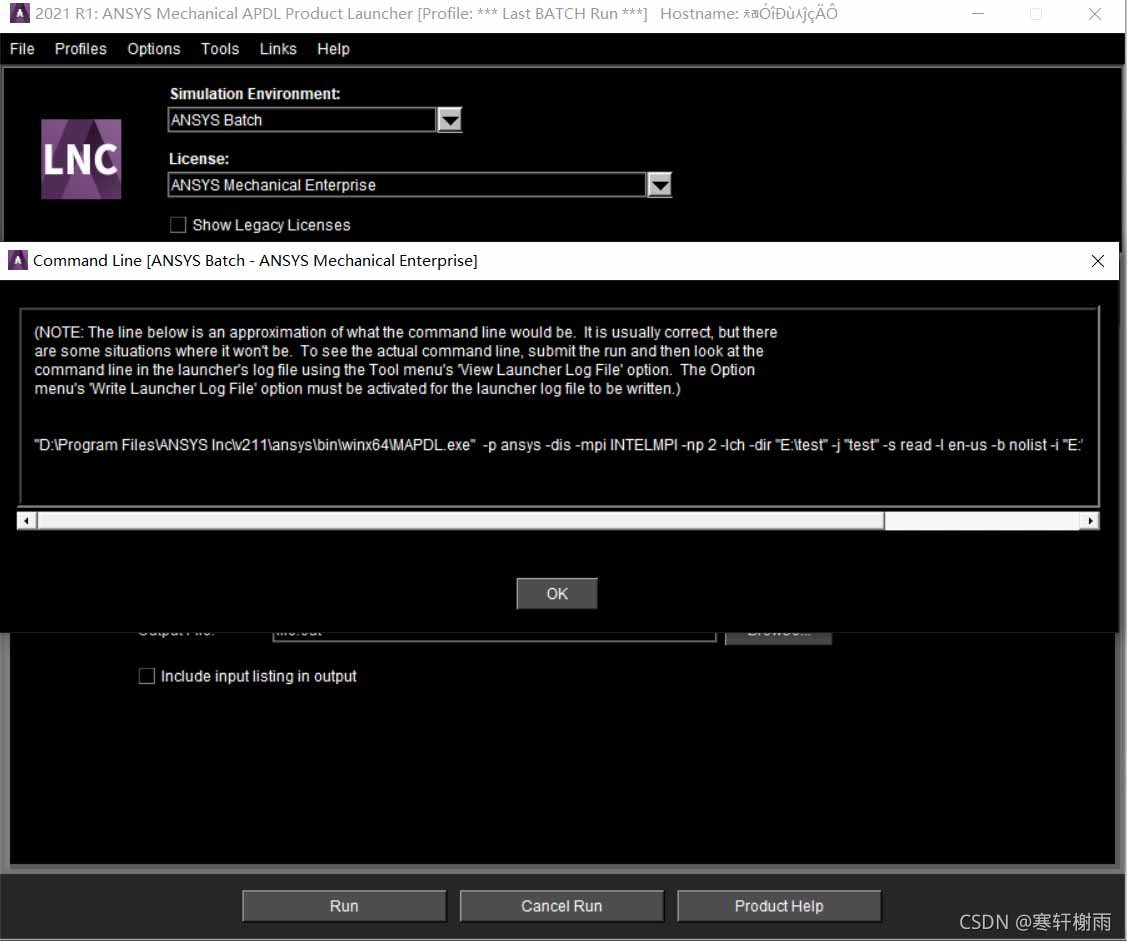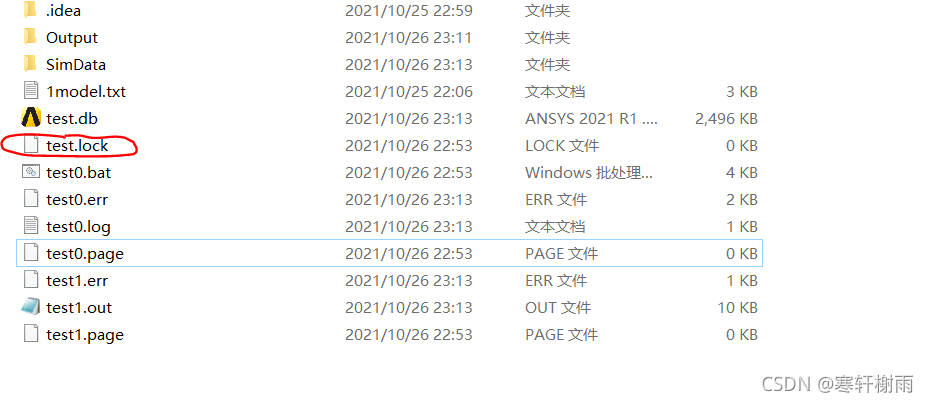.png)
最近做了一个小项目,用python代码进行ansys的二次开发,重点是如何使用python调用ansys.代码如下:
1 2 3 4 5 | import ospath = 'E:/test'os.chdir(path)ansys = r'"D:\"Program Files\ANSYS Inc"\v211\ansys\bin\winx64\MAPDL.exe"" -p ansys -dis -mpi INTELMPI -np 2 -lch -dir "E:\test" -j "test" -s read -l en-us -b -i "E:\test\1model.txt" -o "E:\test\Output\file.out""'os.system(ansys) |
当然了,这么长的一串代码肯定不是人手打的,因为肉眼分辨不出来的空格实在太多了。
具体命令在这里,看图

点击tool的Display Command Line

复制路径,最后一行

但是,直接的复制写进代码是没有用的,因为Python识别不了空格,以及转义字符造成的误解,具体怎么改正可以看上述代码。
我在调试代码中还遇到了ansys lock的问题,如图:

原因就是调试代码同时运行了多个MAPDL文件且input file都是同一个,导致了ansys lock,因为可以看到每次运行代码都会产生一堆.log,.bat,.err文件,一般这些文件不会影响代码的运行,但是下图的.lock文件会是个bug,删除运行产生的不相干文件就可以了

按照官网要求,ANSYS 2021以上,python 3.63.8,以下默认用户电脑已经安装ansys2021,python3.63.8,解释器建议选用pycharm
安装pymapdl包(目前ansys-mapdl-core包只支持这几个版本),通过清华镜像安装,能够得到完整的包,否则由于下载超时会中断,且无法下载到最新的pymapdl-corba模块导致无法实现python连接mapdl
1 2 3 4 5 6 7 8 9 | pip install ansys-mapdl-core -i https://pypi.tuna.tsinghua.edu.cn/simplepip install ansys-mapdl-reader -i https://pypi.tuna.tsinghua.edu.cn/simplepip install ansys.api.mapdl.v0 -i https://pypi.tuna.tsinghua.edu.cn/simplepip install protobuf -i https://pypi.tuna.tsinghua.edu.cn/simplepip install grpcio -i https://pypi.tuna.tsinghua.edu.cn/simplepip install grpcio-tools -i https://pypi.tuna.tsinghua.edu.cn/simplepip install pyaedt -i https://pypi.tuna.tsinghua.edu.cn/simplepip install ansys-dpf-core -i https://pypi.tuna.tsinghua.edu.cn/simplepip install ansys-dpf-post -i https://pypi.tuna.tsinghua.edu.cn/simple |
测试pymapdl是否安装成功
1 2 3 | from ansys.mapdl.core import launch_mapdlmapdl = launch_mapdl()print(mapdl) |
若成功,则会显示ansys版本以及mapdl版本
1 2 3 4 5 | import osfrom ansys.mapdl.core import launch_mapdlpath = os.getcwd()mapdl = launch_mapdl(run_location=path+'\working', exec_file=r"D:\setup_position_1\ansys2021r1\ANSYS Inc\v211\ansys\bin\winx64\ANSYS211.exe",additional_switches="-smp")print(mapdl) |
启动失败原因:
pymapdl语法于ansys apdl语法基本一致,详情可参考二者的官方文档,以下给出一些示例:
1 2 3 4 5 6 7 8 9 10 11 12 13 14 | mapdl.clear()# define element and materialmapdl.prep7()mapdl.units("SI") # SI - International system (m, kg, s, K).# define a ET30 and ET130 element typemapdl.et(1, "FLUID30", kop2=1)mapdl.et(2, "FLUID130", kop1=1)# Define a material (nominal steel in SI)mapdl.mp("SONC", 1, 1500) # sonc in m/smapdl.mp("DENS", 1, 1000) # Density in kg/m3mapdl.mp("SONC", 2, 1500) # sonc in m/smapdl.mp("DENS", 2, 1000) # Density in kg/m3 |
本批处理程序文件移动采用python os,glob以及shutil包,误差分析方法采用二范数误差分析:
1 2 3 4 5 6 7 8 9 10 11 12 13 14 15 16 17 18 19 20 21 22 23 24 25 26 27 28 29 30 31 32 33 34 35 36 37 38 39 40 41 42 43 44 45 46 47 48 49 50 51 52 53 54 55 56 57 58 59 60 61 62 63 64 65 66 67 68 69 70 71 72 73 74 75 76 77 78 79 80 81 82 83 84 85 86 87 88 89 90 91 92 93 94 95 96 97 98 99 100 101 102 103 104 105 106 107 108 109 110 111 112 113 114 115 | import osimport shutildef mkdir(path): path = path.strip() path = path.strip("\\") isExists = os.path.exists(path) if not isExists: os.makedirs(path)def clearfolder(path): path = path.strip() path = path.strip("\\") isExists = os.path.exists(path) if isExists: shutil.rmtree(path) mkdir(path)def mycopyfile(srcfile, dstpath, file_num,filenamelist): # 移动函数 if not os.path.isfile(srcfile): print ("%s not exist!"%(srcfile)) else: fpath,fname=os.path.split(srcfile) # 分离文件名和路径 if not os.path.exists(dstpath): os.makedirs(dstpath) # 创建路径 shutil.move(srcfile, dstpath + str(file_num)+'-'+fname) # 移动文件 print ("copy %s -> %s"%(srcfile, dstpath +str(file_num)+'-'+ fname)) filenamelist.append(dstpath + str(file_num)+'-'+fname)def filename_to_list(filepath): file_name_list = list() # 新建列表 for i in os.listdir(filepath): # 获取filePath路径下所有文件名 data_collect = ''.join(i) # 文件名字符串格式 file_name_list.append(filepath+data_collect) # 将文件名作为列表元素填入 return (file_name_list) # 返回列表def read_ansys_result(filepath, nodenum): ansysdata = [] f = open(filepath, "r") data = f.readline() data = f.readline() for i in range(1, nodenum+1): data = f.readline() data = data.strip().split() ansysdata.append([float(data[1]), float(data[2]), float(data[3])]) return ansysdatadef read_my_result(filepath, nodenum): mydata = [] f = open(filepath, "r") data = f.readline() data = f.readline() data = f.readline() for i in range(1, nodenum+1): data = f.readline() data = data.strip().split() mydata.append([float(data[3]), float(data[4]), float(data[5])]) return mydatadef cal_2Norm_Err_ofMesh(caldata,thedata): nodenum = len(caldata) a = 0 b = 0 c = 0 d = 0 e = 0 f = 0 for i in range(nodenum): a += pow(caldata[i][0] - thedata[i][0], 2) b += pow(caldata[i][1] - thedata[i][1], 2) c += pow(a,2)+pow(b, 2) d += pow(thedata[i][0], 2) e += pow(thedata[i][1], 2) f += pow(thedata[i][2], 2) a = pow(a, 0.5) b = pow(b, 0.5) c = pow(c, 0.5) d = pow(d, 0.5) e = pow(e, 0.5) f = pow(f, 0.5) realerr = a/d imagerr = b/e amperr = c/f err_list = str(realerr)+" "+str(imagerr)+" "+str(amperr) return err_listdef write_2Norm_Err_ofMesh(outputfile, ansysnamelist, mynamelist, thenamelist, fileinfolist): ansys_res_data = [] # 每一个元素代表一个文件的结果 my_res_data = [] the_res_data = [] for i in ansysnamelist: print(i) for i in range(len(ansysnamelist)): ansys_res_data.append( read_ansys_result(ansysnamelist[i], fileinfolist[i][2])) my_res_data.append(read_my_result(mynamelist[i], fileinfolist[i][2])) the_res_data.append(read_my_result(thenamelist[i], fileinfolist[i][2])) f = open(outputfile,"w",encoding='GBK') f.write("Title=\"different mesh num err\"\n") f.write("variables=\"mesh_number\",\"real_err(%)\",\"imag_err(%)\",\"amp_err(%)\"\n") f.write("zone t=\"ansys-theroy\"\n") f.write("i="+str(len(ansysnamelist))+",f=point\n") for i in range(len(ansysnamelist)): ans_the=cal_2Norm_Err_ofMesh(ansys_res_data[i],the_res_data[i]) f.write(str(fileinfolist[i][1])+" "+ans_the+"\n") f.write("zone t=\"my-theroy\"\n") f.write("i="+str(len(ansysnamelist))+",f=point\n") for i in range(len(ansysnamelist)): my_the = cal_2Norm_Err_ofMesh(my_res_data[i], the_res_data[i]) f.write(str(fileinfolist[i][1]) + " " + my_the + "\n") |
使用isubprocess包来调用第三方exe程序,示例如下:
1 2 3 4 | import subprocesscommand= " AcoFEM.exe AcoHarmicINFEM AcoHarmicINFEM.cfg 0 0 0"p = subprocess.Popen(command, shell=True)p.communicate() |
需要注意:
以上为个人经验,希望能给大家一个参考,也希望大家多多支持脚本之家。